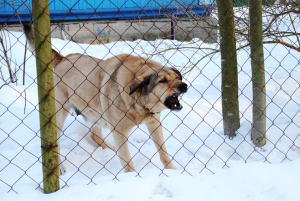 Bark, bark, bark… Dogs bark, that’s a fact, whether we like it or not. But much like when children cry or scream, it’s very hard for us to simply ignore such vocalizations. Barking is loud and often disturbing to the point that a third of all complaints about dogs involve barking. Barking is so problematic that advice about stopping the unpleasant behavior are all over the Internet, not to mention the countless anti-bark collars readily available in every pet store. When dogs bark close to us, the sound of their bark can reach 60-70 decibels. That’s the upper limits used by authorities when evaluating noise complaints. In a kennel, barking can reach 125 decibels (Flint, 2012)! Understanding and treating barking is more than just a matter of comfort to our tired ears, in many cases, it’s a matter of welfare of the dogs. A barking dog can create tension between neighbors and could end up at the pound for nuisance. As always, I like to rely on science as I have learned that popular belief is most often misleading, especially when it comes to dogs. In the recent years, scientific studies have surfaced giving us more insight into the reasons behind our dog’s vocalizations. The studies tell us when they are most likely to occur, and what we can do about them.
Bark, bark, bark… Dogs bark, that’s a fact, whether we like it or not. But much like when children cry or scream, it’s very hard for us to simply ignore such vocalizations. Barking is loud and often disturbing to the point that a third of all complaints about dogs involve barking. Barking is so problematic that advice about stopping the unpleasant behavior are all over the Internet, not to mention the countless anti-bark collars readily available in every pet store. When dogs bark close to us, the sound of their bark can reach 60-70 decibels. That’s the upper limits used by authorities when evaluating noise complaints. In a kennel, barking can reach 125 decibels (Flint, 2012)! Understanding and treating barking is more than just a matter of comfort to our tired ears, in many cases, it’s a matter of welfare of the dogs. A barking dog can create tension between neighbors and could end up at the pound for nuisance. As always, I like to rely on science as I have learned that popular belief is most often misleading, especially when it comes to dogs. In the recent years, scientific studies have surfaced giving us more insight into the reasons behind our dog’s vocalizations. The studies tell us when they are most likely to occur, and what we can do about them.
Why do dogs bark?
Barking is part of the dogs’ communication repertoire. We’re sometimes irritated by barking because we find no motive for the behavior. From our perspective, it’s just unnecessary noise. To the dog however, barking has a specific function and can help them communicate with other dogs or even with humans. It’s even possible that barking has developed in dogs as a consequence of domestication with humans, since dogs bark in a many more situations than their wild counterparts (Flint, 2012).
Let’s take a quick look at a few of the reasons why a dog can bark:
- It’s an effective way to alert other members of their group that an intruder is approaching, like a “hey, hey, pay attention!” It also lets the intruder know that he/she has been spotted. Dogs can bark at unfamiliar or sudden noises or to visual triggers like a cat, a stranger or another dog passing by.
- Barking can also express excitement during play or when a family member comes home. It’s a way to get the attention of another dog to come play, or the family member to greet them.
- When left alone, barking conveys distress or extreme anxiety from being left behind. Barking in this context can sometimes develop into a full-blown panic attack where the dogs can cause damage to their crate, the house or even to themselves in an attempt to get out.
- Dogs can bark when they’re afraid of certain noises like thunder or fireworks.
- The dog can get attention from the owner when bored or when wanting something, like going out, playing or food.
 How much a dog will bark may be influenced by genetics. Some breeds have actually been selectively bred for their tendency to bark, like hunting dogs, herding dogs or terriers. So when we bring home a beagle, for instance, we have to be prepared to put up with barking. Expecting such dogs not to bark is unrealistic and unfair to the dog. On the other hand, certain breeds hardly bark at all, like the chow-chows or sharpeis. Certain individuals within a breed can also have a higher tendency than others of the same breed to bark. A study involving Finish Spitz, for instance, showed that we could influence how much dogs bark through selective breeding (Karjalainen, 1996). It seems that with so many problems due to barking, breeders would be encouraged to preferably breed the dogs with the least tendencies to bark.
How much a dog will bark may be influenced by genetics. Some breeds have actually been selectively bred for their tendency to bark, like hunting dogs, herding dogs or terriers. So when we bring home a beagle, for instance, we have to be prepared to put up with barking. Expecting such dogs not to bark is unrealistic and unfair to the dog. On the other hand, certain breeds hardly bark at all, like the chow-chows or sharpeis. Certain individuals within a breed can also have a higher tendency than others of the same breed to bark. A study involving Finish Spitz, for instance, showed that we could influence how much dogs bark through selective breeding (Karjalainen, 1996). It seems that with so many problems due to barking, breeders would be encouraged to preferably breed the dogs with the least tendencies to bark.
What can we do about it?
There is NO quick fix to barking. As much as we would love to just be able to stop the barking with little effort on our part, quick fixes simply do not work, or worse, have a very high chance of backfiring. Since many countries (and some veterinarians) do not support the practice of debarking dogs, it’s very tempting to turn to the next available option: the anti-bark collar.
Anti-bark collars are easy to find and provide a rather cheap option for the owner’s frustration with the behavior. Their basic principle is to teach the dog that barking leads to unpleasant consequences. Some will release a spray of citronella or air into the dog’s face. Others will emit a high frequency sound or an electric shock. A survey of owners who resorted to such collars reported that a little over half of the dogs reduced their barking in the short term. However, when we look at long term efficiency only about 16% reported they actually worked. The biggest issue with these devices is that they can make the problem worse, even a lot worse! According to this study, users of citronella and electronic collars reported (22% and 40% respectively) increased fear in their dogs after wearing these devices (Yin & Richardson, 2006);(Theo Stewart, 2015, “What does Citronella really do to a dog?”).
Why don’t anti-bark collars work in the long run? Barking in play, or to ask to be let out, are only occasional and don’t generally bother us much so most owners will use anti-bark collars to treat barking that is perceived as a nuisance. A recent study counted the barks of 25 dogs reported as being nuisance barkers, over a period of 7 days (Raglus & al. 2015) and showed that one of the main forms of unwanted barking is reactive barking, in other words, barking at environmental triggers, like people and dogs walking by. Reactive barking happens when the dog perceives the stimuli as a threat. Would we slap our kid when he/she screams at the sight of a spider? If a dog is concerned or afraid of something or someone approaching, does it make sense to make the situation even worse for the animal and inflict discomfort or pain? We might inhibit the barking at first, but the underlying emotion is not only ignored it is potentially made worse as we’ve just given the dog another reason to be scared: bad things happen when people or dogs walk by the house. In the case of dogs being left alone at home, the same dynamic is at play. The dog is anxious or scared of being left alone and is now punished when vocalizing. It’s easy to see how the consequences of such methods can truly backfire and we may end up with much increased fear in our beloved pooch.
How to treat barking?
With different underlying causes to the barking, also come different ways to approach the problem. We’ll focus on the barking that has been deemed a nuisance in this last study. For more details about the other forms of barking, you can read “Dog barking: different types and treatments”
Reactive barking
 When dogs are barking at an intruder, they’re alerting the other members of the group of the presence of the intruder while trying to scare him/her away. When we understand that the underlying cause is anxiety or even fear, we can develop strategies that will help our dog develop more confidence. Safety is the number one concern that we all have for ourselves, and that’s also true about our dogs. When dogs are let outside on their own for extended periods of time or can watch passerbys through the window inside their home, they experience over and over the following sequence: scary person/dog approaching – bark, bark, bark – scary person/dog leaving. It doesn’t matter that the barking had nothing to do with the intruder going away. To treat the problem, two things have to happen: 1/ the dog should be removed from the situation so that the sequence cannot repeat itself. Every time this happens, the neural connections in the brain get stronger and the behavior becomes more and more of a habit. 2/ The trigger has to be paired with good things happening to the dog. To do that, we’ll want to make sure that we are with the dog when people/dogs walk by, that we are at a distance from the trigger that allows the dog to stay calm and under threshold (more information about thresholds : “Fear, Fireworks & Neuroplasticity: What you should never do when your dog is afraid”). Also, we want to pair the presence of the passerby with good things happening to the dog (like treats). Just like with any training or behavior modification protocol, repetition is key and nothing happens over night. After a few sessions, the dogs will start looking at the trigger then looking back at us, expecting a treat. We’ll gradually be able to get closer and closer and eventually the dog won’t be worried anymore and we’ll be able to gradually decrease the rewards until we no longer need them. At that point, we may decide to let the dog out alone again. To help with the transition, we can use a remote treat dispenser like the Pet Tutor®, that will allow us to still reward the dog while we are out of sight.
When dogs are barking at an intruder, they’re alerting the other members of the group of the presence of the intruder while trying to scare him/her away. When we understand that the underlying cause is anxiety or even fear, we can develop strategies that will help our dog develop more confidence. Safety is the number one concern that we all have for ourselves, and that’s also true about our dogs. When dogs are let outside on their own for extended periods of time or can watch passerbys through the window inside their home, they experience over and over the following sequence: scary person/dog approaching – bark, bark, bark – scary person/dog leaving. It doesn’t matter that the barking had nothing to do with the intruder going away. To treat the problem, two things have to happen: 1/ the dog should be removed from the situation so that the sequence cannot repeat itself. Every time this happens, the neural connections in the brain get stronger and the behavior becomes more and more of a habit. 2/ The trigger has to be paired with good things happening to the dog. To do that, we’ll want to make sure that we are with the dog when people/dogs walk by, that we are at a distance from the trigger that allows the dog to stay calm and under threshold (more information about thresholds : “Fear, Fireworks & Neuroplasticity: What you should never do when your dog is afraid”). Also, we want to pair the presence of the passerby with good things happening to the dog (like treats). Just like with any training or behavior modification protocol, repetition is key and nothing happens over night. After a few sessions, the dogs will start looking at the trigger then looking back at us, expecting a treat. We’ll gradually be able to get closer and closer and eventually the dog won’t be worried anymore and we’ll be able to gradually decrease the rewards until we no longer need them. At that point, we may decide to let the dog out alone again. To help with the transition, we can use a remote treat dispenser like the Pet Tutor®, that will allow us to still reward the dog while we are out of sight.
Barking when left alone
Here again, we’re dealing with anxieties due to the separation with us. For dogs, being left behind is unnatural and many suffer from separation anxiety. The best way to treat separation anxiety is just like in the previous case, remove the trigger (being left alone) and very gradually expose the dog to low levels of separation that the dog can handle while pairing them with good things happening (typically treats or food in some form). A stuffed Kong®, a remote treat dispenser like the Pet Tutor®, puzzle games, etc. For more details about protocols to treat separation anxiety you can go to “Separation Anxiety in Dogs – A Consultant’s High Tech Toolkit” or “Why do some dogs have separation anxiety when others don’t?” I also highly recommend Malena DeMartini’s book on the subject “Treating separation anxiety in dogs”.
One of the reasons why we seem to struggle so much with the treatment of barking is that we tend to want to deal with the problem by reacting to it rather than taking pre-emptive measures. What I mean by that is that once the dog barks, we want to stop the behavior, we take action to interrupt and/or punish. In most cases however, we fail to recognize that it’s far more difficult for the dog not to bark than it is to bark. We would have better chances of success by rewarding up front for not barking. We know what are the potential triggers for a dog: strangers, other dogs, people on bicycles, kids running, etc. The puppy watches a stranger go by, lets immediately give the pup a treat; a dog passes by, another treat. We can pair any potential triggers with good things happening. Do we become big treat dispensers, absolutely! But as the dog gains confidence that the world is full of great opportunities, we can gradually reduce the rewards until we don’t give them anymore.
Treating barking with the Pet Tutor®
One example of the use of food to help the dog develop positive associations in a potentially unpleasant situation is in the crate. We can expect that the dog may not be totally comfortable in a crate. When crates are introduced properly they can be valuable training tools. But they can also be associated with separation from the rest of the group, a loss of freedom and control and therefore a cause of distress. One way to help the dog develop a positive associating with the crate is to feed them in their crate. I also found that using the Pet Tutor® in this situation made a world of difference (see video below). I don’t wait for dogs to bark, as this would be the equivalent of waiting for them to be over threshold. Instead, we can start treating the dog as soon as he/she is in the crate. As the treats drop in the crate every few seconds over a period of time, the dog’s focus is on waiting for the next treat, not on the anxiety of being crated. Since this goes on for several minutes, our experience has been that most dogs gradually relax and tend to be quite comfortable by the time the Pet Tutor® is done dispensing.
As we learn to read dogs we start recognizing how much anxiety many dogs go through in their life. With little control over what happens to them and owners who don’t always know how to chose the right dog or how to properly care for them, many dogs experience anxieties and fears that can be expressed by barking. We consider barking to be a nuisance when it’s really a symptom that our pooch needs extra help in certain areas. Waiting for the dog to “grow out of it” simply doesn’t work. There are however effective solutions to the boisterous problem and with careful planning we can help the dog reduce the need for such loud demonstrations. We have to be smart about it though and treat the behavior at its roots instead of looking for easy and quick fixes that rarely work.
Jennifer Cattet Ph.D.


Thank You
Happy Paws
Doug